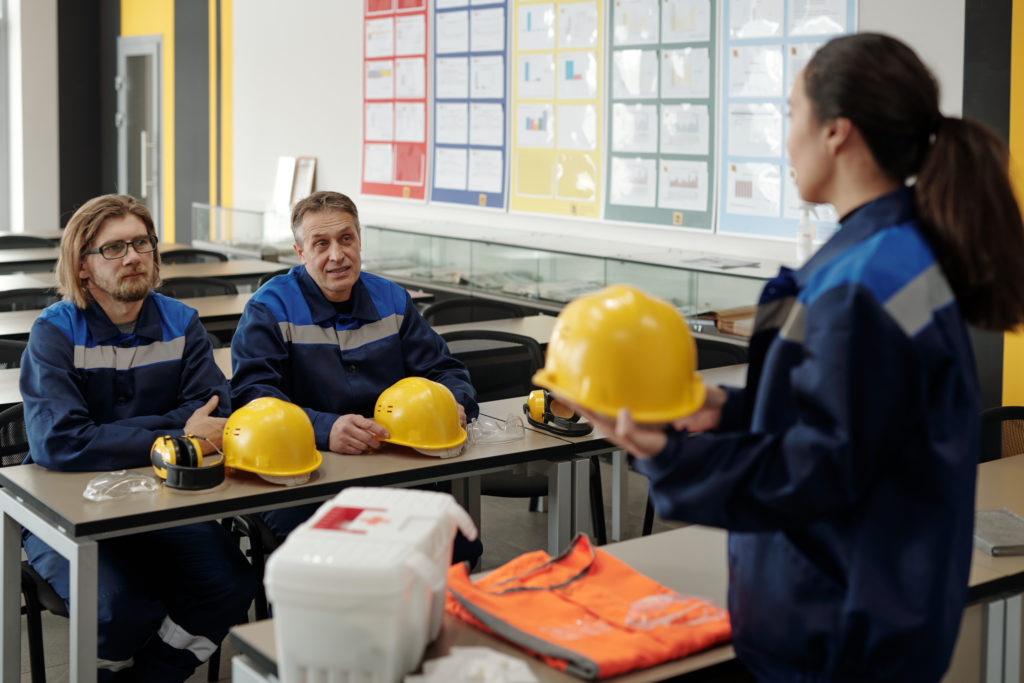Project Insights Report
Creating a Microlearning Model for the Canadian Mining Industry
 Executive Summary
Executive Summary
The mining industry is suffering from labour shortages that are expected to worsen. The industry needs to invest in training to ensure that new and existing workers gain and maintain the skills to do their jobs effectively. However as mining is a 24-hour operation, it leaves very little room for workers to step away to participate in training.
Using an existing competency framework from the Mining Industry Human Resources Council, and extensive input from front-line workers and supervisors, this project developed 10 microlearning modules and accompanying coaching supports on behaviour-based safety and communication. The goal of the project was to improve safety, communication, and performance of workers in remote mining operations in Newfoundland and Nunavut.
While the project successfully developed and implemented the microlearning modules, it experienced challenges with limited digital literacy and access, as well as limitations in the comfort of supervisors to act as coaches and facilitators of microlearning content.
The project holds lessons for other industries that have mostly deskless employees working in a 24-hour operation. It also encourages funders and policymakers to support industry-led initiatives to address skills challenges.
Key Insights
137 workers successfully completed the microlearning modules and received a communications microcredential.
On average, employees engaged in microlearning for 13.5 minutes a day across 90 working days.
Microlearning reminded more experienced workers of the behaviour-based skills necessary for creating a safe workplace.
 The Issue
The Issue
The mining industry faces challenges adopting new technologies, adapting to new regulations, assessing the skills of current workers, and providing effective training in remote locations. Mining is a 24-hour operation creating real constraints on the amount of time an employee can be off the job to train. In addition to the operating challenges, many workers have had limited experience with formal post-secondary or adult education, and most are deskless and have limited access to computers while at work.
Microlearning offers workers brief opportunities to engage with relevant topics and has been a useful approach for workers with limited time, control, and continuity, such as those in manufacturing. Microlearning is meant to refresh knowledge and help a worker apply this knowledge in the flow of work. By using familiar scenarios and work environments microlearning demonstrates how specific skills can be used on the job.

 What We Investigated
What We Investigated
In this project, Signal Gold (formerly Anaconda Mining), Agnico Eagle Mines, Training Works, and the Mining Industry Human Resources Council (MiHR) partnered to create a comprehensive workplace-based microlearning delivery model on behaviour-based safety and communication skills in mining. The training program aimed to improve safety, communication, and performance of workers in remote mining operations.
The project occurred in two rural communities, the Signal Gold Pointe Rousse Project in Newfoundland and the processing plant of the Agnico Eagle Meliadine mine in the Kivalliq District of Nunavut.
To develop the microlearning content, the project team analyzed incidents and accidents onsite, interviewed and shadowed the employees, and consulted with health and safety professionals to understand the skills gap and learning needs of the workforce.
From this information gathering, the team created a behaviour-based safety competency model, integrating the Mining Industry Human Resource Council’s National Occupational Standards for a minerals processing operator, that defined the skills required to stay safe and communicate effectively on the job. The competencies included mindfulness, vigilance, active listening, effective inquiry, closed-loop communication, assertiveness, strategic decision-making, team building, workload management and coaching. Participating workers completed a skills-gap assessment related to these identified competencies, answering scenario-based questions as well as self assessments for each competency.
In response to the assessments, the project team developed 10 microlearning training modules on each of the identified competencies. The modules took the form of videos, podcasts, infographics, job aids, and guided discussions. Employees could engage with the modules on their own mobile devices, and led by coaches, the modules were discussed with groups of workers during pre-shift meetings. The microlearning ranged in length from five to 35 minutes. Participants who successfully completed the training received a nationally recognized safety micro-credential from the MiHR.
The microlearning was complimented by on-the-job coaching from experienced leaders who guided and mentored workers on the floor. The coaching program was developed to help deliver the microlearning program and help participants with transferring knowledge into behaviour on the job. Each coach attended training sessions with the Training Works project team and were given a presentation to understand the project and the competency model they would be using. Coaches received a handbook that explained each competency, behaviours to look for on the job, directions on how to present the video, activity, or formats, and what to focus on in the training and discussion questions for a team conversation.
 What We’re Learning
What We’re Learning
At the Meliadine mine in Nunavut, 95 workers started the program and 79 completed. On average, employees engaged in microlearning for 13.5 minutes a day across 90 working days, equating to 16.4 hours of training per participant and over 1,000 hours of training for the organization. A total of 68 MiHR communication micro-credentials were awarded to the participants at Agnico Eagle.
There were fewer participants at the Signal Gold mine in Newfoundland, because the closing of the mine was announced mid-implementation. In total 69 workers at this location received the MiHR micro-credential.
While not all participants completed the pre- and post-skills assessments, small increases were noted across the 10 competencies for those that did, with the largest increases in effective inquiry, active listening, decision making and workload management.
Digital literacy development
At both operational sites, limited bandwidth and a lack of digital literacy restricted employees’ access to the Digital Competency Tool. Although most employees have access to or use mobile devices on a regular basis, there are still those who are unfamiliar with the operation of these devices and those who remain uncomfortable navigating websites and tools on their own. It is important to provide information and instruction upfront and to provide interactive demonstrations so the employees can become familiar with the device and navigation. The project team provided a written guide on how to use mobile devices and navigate through the competency tool as well as had someone onsite demonstrating the tools for employees to use. Providing an instructional video would have provided an opportunity for employees to learn how to navigate and watch the video multiple times if necessary. In the end, the solution was for employees to complete the assessment on paper and work with the change manager to input into the digital competency tool.
Training the coaches
The project team selected individuals in supervisory roles as coaches for the on-the-job coaching component, based on their leadership qualities, supervisory training, and mobility on the floor. However, the team realized that the coaches had different levels of training and experience, and needed more support to deliver microlearning effectively. Shortly after implementation began, the coaches expressed the need for additional support to introduce microlearning and guidance to start discussions. The coaches were nervous about presenting the microlearning and were unsure of how to introduce the daily topics. Therefore, the team developed a coaching handbook and worked with the coaches and the leadership team to ensure the coaching was aligned with the organizational goals and culture.
Microlearning acted as reminders for experienced workers
Microlearning is best suited and leveraged as daily reminders to commute knowledge into behaviour as opposed to teaching brand new skills. Many of the experienced workers who participated in this project had already received behaviour-based skills training in the past and considered the content of microlearning to be repetitive. While microlearning provided them with limited new learnings, it did serve as a reminder of the behaviour-based skills necessary for creating a safe workplace. With many incidents and injuries occurring as a result of an experienced worker becoming complacent, alternative delivery models may pique their interest and heighten engagement with this audience.
 Why It Matters
Why It Matters
According to the Mining Industry Human Resources Council, Canada’s mining industry is suffering from labour shortages that are expected to worsen. An aging workforce coupled with a lack of interest from young people, women and newcomers has led to a growing number of jobs going unfilled. These shortages have widespread impacts, as critical minerals and metals play an important role in the transition to a net-zero economy.
Innovative efforts, like the microlearning developed in this project, are part of a wider strategy to ensure that new and existing workers in mining gain and maintain the necessary skills to effectively do their jobs. This project provides a detailed account of how employers and training organizations can work together to leverage existing competency frameworks to create training for in-demand skills. The project also highlights improvements for how to tailor microlearning modules for more effective uptake, specifically using real-life scenarios and ensuring supervisors and coaches are trained themselves to deliver on-the-job content. These lessons will be especially helpful to other industries with similar challenges, such as mostly deskless employees and a 24-hour operation schedule.
Funders and policymakers in the training and skills ecosystem should explore ways to support more industry-driven and workplace-based learning projects, as they can generate innovative and collaborative solutions for the skills development challenges.

State of Skills:
Leveraging the Skills of Newcomers
The quality and intensity of employer engagement is critical to the overall success of interventions to support newcomers.
 What’s Next
What’s Next
Agnico Eagle Mining, one of the project partners, is going to implement the microlearning program throughout all the operations in Meliadine, reaching 3,000 workers. The Mining Industry Human Resources Council, another project partner, is promoting the workplace-based learning model among its clients and stakeholders.
The project has also secured new investments and partnerships from other sectors and organizations that see the value and potential of the microlearning approach. Training Works, the project lead, has received funding from Canada’s Ocean Supercluster, the Government of Newfoundland and Labrador, and Energy Research and Innovation Newfoundland and Labrador to adapt and apply the microlearning model to the marine transportation industry, with a focus on fatigue management.
Have questions about our work? Do you need access to a report in English or French? Please contact communications@fsc-ccf.ca.
More from FSC
National Accessibility Resources for Employers (NARE)
Lost opportunities: measuring the unrealized value of skill vacancies in Canada
Young Newcomers and International Students in Diploma Programs: Shock-proofing through Language Confidence
Creating a Microlearning Model for the Canadian Mining Industry is funded by the Government of Canada’s Future Skills Program. The opinions and interpretations in this publication are those of the author and do not necessarily reflect those of the Government of Canada.




